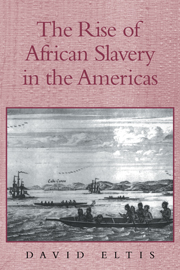Book contents
- Frontmatter
- Contents
- List of Tables
- List of Maps
- Preface
- Abbreviations
- Chapter 1 Slavery and Freedom in the Early Modern World
- Chapter 2 The English, the Dutch, and Transoceanic Migration
- Chapter 3 Europeans and African Slavery in the Americas
- Chapter 4 Gender and Slavery in the Early Modern Atlantic World
- Chapter 5 Productivity in the Slave Trade
- Chapter 6 Africa and Europe in the Early Modern Era
- Chapter 7 The African Impact on the Transatlantic Slave Trade
- Chapter 8 The English Plantation Americas in Comparative Perspective
- Chapter 9 Ethnicity in the Early Modern Atlantic World
- Chapter 10 Europe and the Atlantic Slave Systems
- Epilogue on Abolition
- Appendices
- Maps
- Sources and Bibliography
- Index
Chapter 6 - Africa and Europe in the Early Modern Era
Published online by Cambridge University Press: 05 August 2012
- Frontmatter
- Contents
- List of Tables
- List of Maps
- Preface
- Abbreviations
- Chapter 1 Slavery and Freedom in the Early Modern World
- Chapter 2 The English, the Dutch, and Transoceanic Migration
- Chapter 3 Europeans and African Slavery in the Americas
- Chapter 4 Gender and Slavery in the Early Modern Atlantic World
- Chapter 5 Productivity in the Slave Trade
- Chapter 6 Africa and Europe in the Early Modern Era
- Chapter 7 The African Impact on the Transatlantic Slave Trade
- Chapter 8 The English Plantation Americas in Comparative Perspective
- Chapter 9 Ethnicity in the Early Modern Atlantic World
- Chapter 10 Europe and the Atlantic Slave Systems
- Epilogue on Abolition
- Appendices
- Maps
- Sources and Bibliography
- Index
Summary
As Chapter 2 has made clear, after an initial phase in which Europeans first plundered and then traded with the peoples of the overseas world they had contacted, European interest in the Americas and Africa quickly came to center on the production of commodities. From a global perspective this behavior was unusual. It did not characterize the many Chinese expeditions that reached out to East Africa in the early fifteenth century, nor the more enduring trans-Saharan trading diasporas of Islam, nor the Aztec domination of the peoples of what is now northern Mexico. The Inca empire in South America and Arab networks in the Indian Ocean put some stress on production, but the scale of the European commitment remains unmatched. Trade or payment of tribute by the weaker to the stronger power was universal; systematic attempts by the stronger to increase the production of goods in the society of the weaker – with or without the help of the dominated – was not. In the Americas, such a preoccupation was associated with the gradual European conquest of the aboriginal peoples and the establishment of European settlements. With the single exception of the fur trade (always a tiny fraction of total transatlantic trade), trade between American aboriginals and Europeans was never more than trivial. Most transatlantic trade was between communities of Europeans. In Africa, the production of goods (and people) for trade remained in the hands of Africans.
- Type
- Chapter
- Information
- The Rise of African Slavery in the Americas , pp. 137 - 163Publisher: Cambridge University PressPrint publication year: 1999



